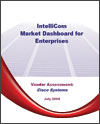December 14, 2006
Making the Case for VoIP: AT&T White Paper Summary
 By Mae Kowalke, TMCnet Contributor
By Mae Kowalke, TMCnet Contributor
By many estimates, Voice Over IP, or VoIP , has reached a critical tipping point; the technology now offers compelling return on investment (ROI) for enterprises. One such enterprise is phone service provider AT&T (News - Alert), which spent years testing possible uses for VoIP, and now is rapidly working to deploy VoIP throughout the company.
, has reached a critical tipping point; the technology now offers compelling return on investment (ROI) for enterprises. One such enterprise is phone service provider AT&T (News - Alert), which spent years testing possible uses for VoIP, and now is rapidly working to deploy VoIP throughout the company.
In a recent white paper, AT&T shared its experience with VoIP and detailed how a winning business case was created for bringing the new technology within the walls of the corporation.
The full white paper, summarized below, is available to download from TMCnet’s White Paper Library.
The Challenge
Like the companies it serves, AT&T’s two main business challenges are helping employees work efficiently, and keeping costs down. At the 1990s drew to a close, AT&T saw that using VoIP in its business operators could increase efficiency and reduce total cost of ownership (TCO ) below that presented by legacy systems.
) below that presented by legacy systems.
“AT&T leaders believe strongly that AT&T should use the very same business solutions that the company offers its customers,” the company said in its white paper. “Nothing teaches as effectively as direct experience. So the company challenged itself to become a test bed for VoIP, put the technology to work and learn from the inside how to help customers use VoIP to deliver maximum business value.”
The Planning and Implementation Process
AT&T started off by testing VoIP in its own IT department, a move made to address questions such as quality, features, and management. In the process the company discovered that some VoIP implementations delivered stronger ROS than others.
As it turned out, the strongest ROI in the beginning was realized by implementing VoIP at new facilities or locations outside the U.S. From there, VoIP use in the company was gradually increased, reaching existing U.S. sites in 2004. By that year, 40 percent of AT&T employees outside the U.S. were using VoIP.
AT&T’s methodical approach to adopting the new technology ensured that it realized ROI in a sustainable manner, responding to decreasing price of VoIP equipment and services.
“Early on, the high cost of IP telephones (around $500 each) made it too expensive to replace legacy PBX’s (News - Alert), plus the steady decline of U.S. long distance rates undercut the VoIP toll-savings advantage,” the company said in its white paper.
telephones (around $500 each) made it too expensive to replace legacy PBX’s (News - Alert), plus the steady decline of U.S. long distance rates undercut the VoIP toll-savings advantage,” the company said in its white paper.
The whitepaper continued: “Today transport costs have stabilized, while the cost of IP phones has dropped from $500 to $350 or less. Mobile and home-based employees use a $50 IP softphone, cutting equipment costs even more. The aging of AT&T’s legacy phone systems has provided added incentive, since most of those systems are now reaching the end of their useful life.”
As 2006 draws to a close, the transition to VoIP is nearly complete; virtually all of AT&T’s employees use VoIP services delivered using the company’s MPLS-enabled IP network.
Benefits of VoIP Today
IP telephony is well on its way to becoming the new communications standard, which indicates that the technology is mature. AT&T’s internal experience with VoIP helped it develop the Dynamic Network ApplicationsSM portfolio of IP services now available to the company’s customers.
For those customers, and for AT&T itself, VoIP offers many advantages, a few of which are summarized below.
Increased Productivity – portable, single reach numbers let employees work while on the go by receiving business calls regardless of worker location
Speed of Deployment – In some cases, for example, IP call centers have been deployed in as few as six weeks.
Control – VoIP allows users to customize their communications features, such as call forwarding and speed-dialing.
Mobility – Using IP softphones, remote users and travelers can access enhanced communications features—like multi-users conferencing and voice messaging—from any location.
The table below summarizes where AT&T see the strongest payoff existing for adopting VoIP, and how long it will take to realize ROI in different locations.
|
|
New Sites
|
Existing Non-U.S. Sites
|
Existing U.S. Sites
|
|
Transport
|
Same as existing sites
|
20-50 percent cost reduction
|
Breakeven
|
|
Capital/Lease Expense
|
25 percent lower to deploy
|
Varies by situation
|
35-50 percent higher for equipment; 30 percent savings in ports
|
|
Yearly Operating Expense Savings
|
$500-$890 per user
|
$690-$1070 per user
|
$500-$890 per user
|
|
Net payback
|
1 year
|
1-1 ½ years
|
1 ½-3 years
|
Lessons Learned
In the course of its own experience adopting VoIP, AT&T uncovered some important insights useful for other enterprises considering a similar move to next-generation telephony. Three of those insights are summarized below.
Manage Call Quality End-to-End – Comprehensive monitoring of sound quality is key to making VoIP succeed.
Save to Re-Invest – Start by deploying VoIP at the sites where the TCO savings are greatest, and use the cash flow generated by those savings to fund future deployments.
Take it to the Net – A network-based VoIP system is superior compared to a dedicated, on-site PBX because it minimizes both risk and investment in premises equipment.
because it minimizes both risk and investment in premises equipment.
In concluding its white paper, AT&T said that the advantages of next-generation telephony now offer strong ROI opportunities, and as such, the time for VoIP is now.
To learn more about VoIP and related topics, please visit TMCnet’s White Paper Library.
- - - -
Mae Kowalke previously wrote for Cleveland Magazine in Ohio and The Burlington Free Press in Vermont. To see more of her articles, please visit Mae Kowalke’s columnist page. Also check out her Wireless Mobility blog.














